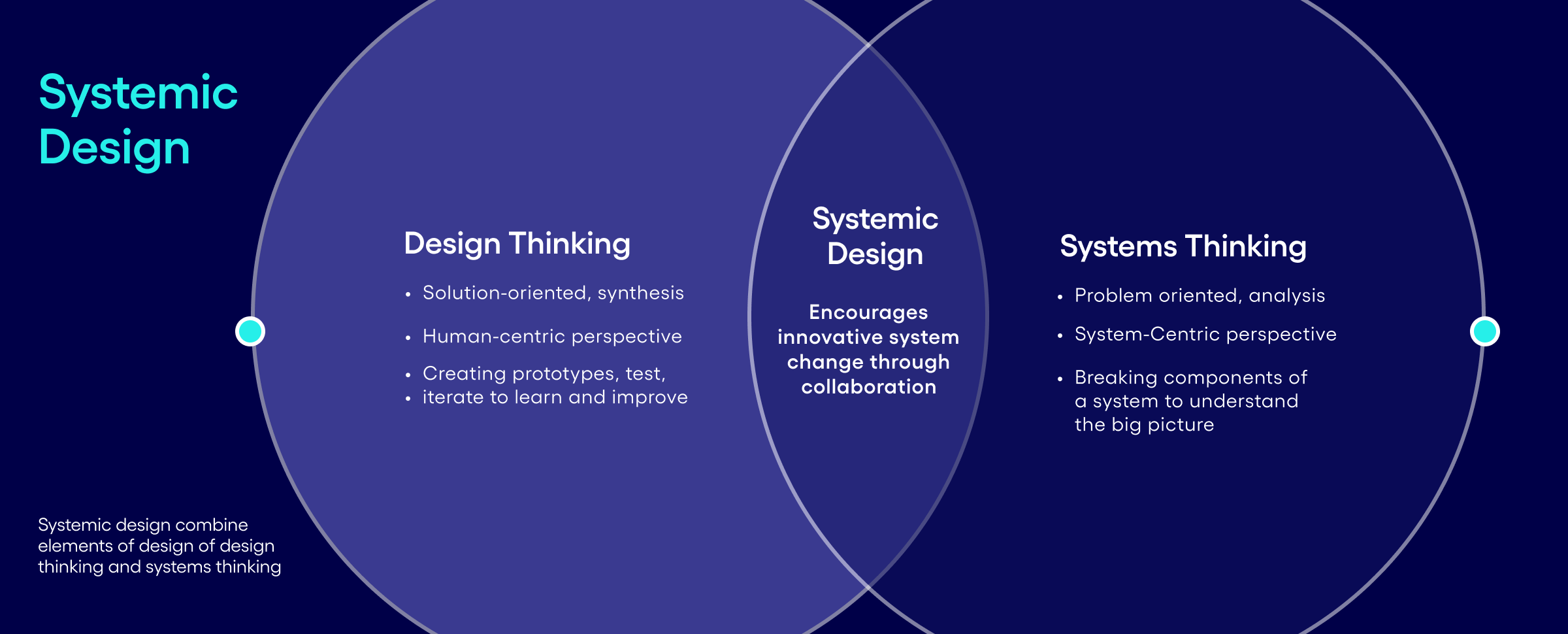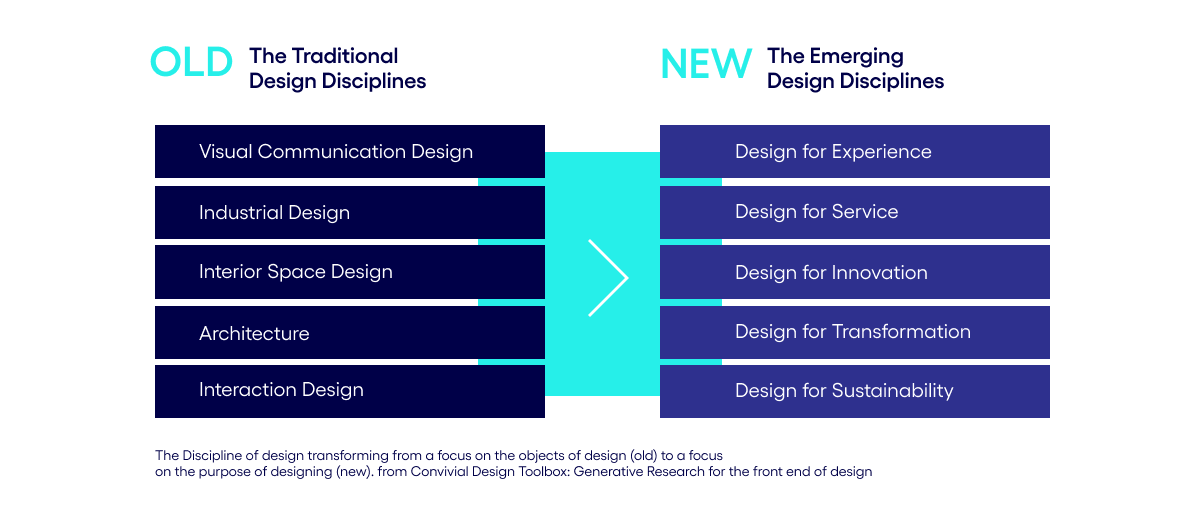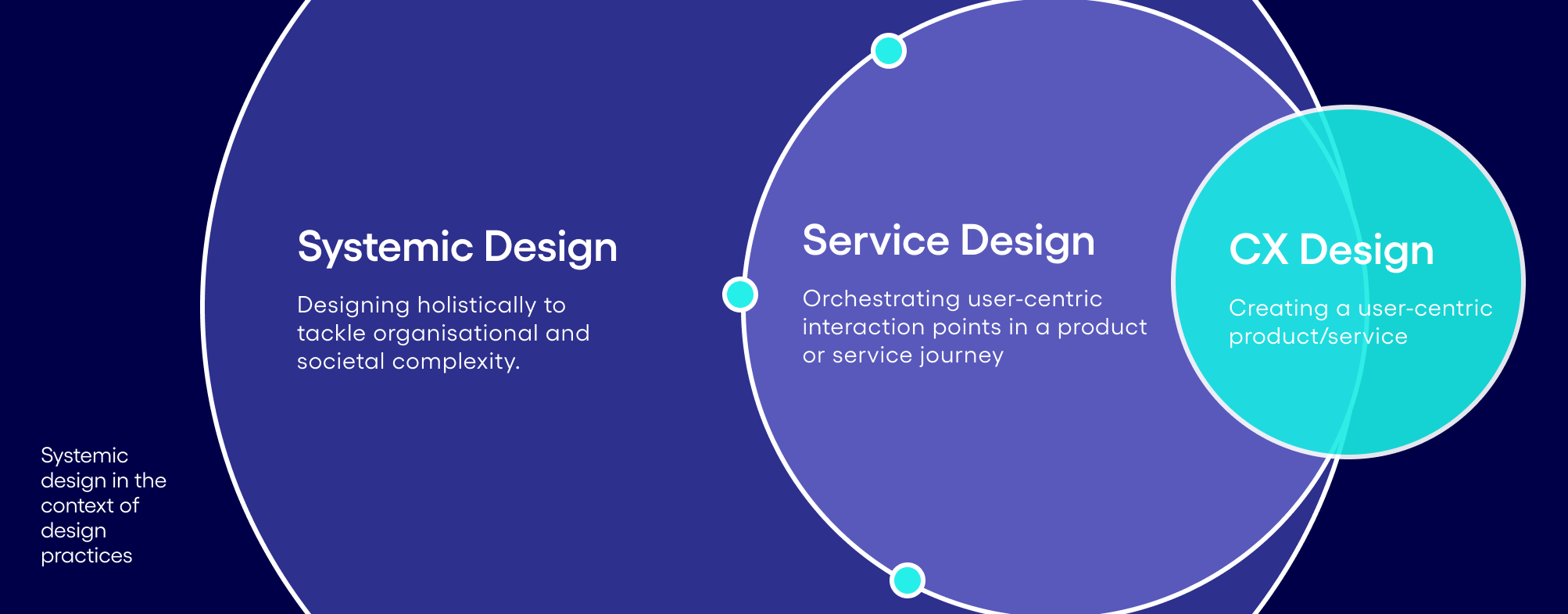When I started exploring systemic design, I was astonished to learn that systems thinking (one of its core elements) has existed since antiquity and has influence in mathematics, psychology, biology, game theory, and social network analysis. However, even though systems thinking is a comprehensive approach to problem-solving, it has not been widely used to solve business challenges. Why has it taken so long for systems thinking to be used in day-to-day businesses practices? And why are the emerging design practices the perfect vehicle in bringing it forward?

Why Has Systems Thinking Existed for so Long but Has Not Been Adopted at Scale?
Russell Ackoff, one of the pioneers of systems thinking, was once asked why so few organizations adopt it. He answered that there were two main reasons: "A 'general’ reason: responsible for organizations failing to adopt any transforming idea; and a ‘specific’ one: responsible for the failure to adopt systems thinking in particular.” [1] (Ackoff, 2006)
The “General” Reason
Our world is made of many complex relationships and inter-relationships. Systems thinking intends to provide a holistic view of it, looking into the parts that compose it, their needs, behaviors, and indented and unintended influences between each other.
Systems thinking is not part of our natural way of seeing and navigating the world. Our corporate and public entities work by breaking themselves into specialized departments, that focus on fragmented parts of a system. We feel comfortable in these specialized bubbles, where we have control and deep knowledge. Specialization is necessary but has the disadvantage to establish ‘silos’ that are far from getting a holistic understanding of the complexity of its context [2] (Wettre, Sevaldson, & Dudani, 2019).
Think about trying to provide solutions for the upcoming gig economy. To create real impact, it’s not enough to design a new technology platform (the design and technological approach)— you need to be able to intervene at several levels of the system, for example creating new ways of brokering jobs, new policies, new insurance models, new types of unions and new models for ongoing learning. You also need to orchestrate these solutions in a way in which they leverage impact through each other.
Creating solutions that provide true change require a holistic view into the challenge. A view that is not achieved by seeing the world only through specializations. This implies:
- A multidisciplinary view of the problem.
- Collaboration among different actors and expertise which, let’s be honest, is still a painful and challenging process.
- An understanding of how stakeholders, products, and services interact and influence the emergent behavior of the system.
The fact that fragmentation is within our standard way of working, and the difficulty to break that status quo, brings us indeed into an impossibility for companies and public entities to approach products, services and day to day challenges from a systems thinking perspective.
The “Specific” Reason
The second, so-called “specific” reason Russell referred to, had to do with the complexity itself of understanding systems thinking. He said, “Very few managers have any knowledge or understanding of systems thinking, and for good reason. Very little of our literature and lectures are addressed to potential users.” [2] (Ackoff, 2006). Systems thinking is theoretical and complex. Very little has been done to make it applicable in day-to-day work-setups.
What Emerging Design Practices Bring to the Game
Systemic design has emerged as a practice where the best of systems thinking, and design thinking come together. But what I love most of systemic design is the idea to give systems thinking a hands-on approach.
In the past decade, design has evolved as a discipline where the focus is no longer on the objects of design, but on the purpose of designing. [3] (Sanders, 2012). In this transition, approaches and methods as co-design and participatory design have emerged, bringing additional skills to designers’ toolsets.

Designers have become experts in creating tools, and guiding activities and methodologies that enable collaboration between different disciplines. These tools and activities break silos, which is the first step in the creation of the ‘common understanding of a challenge’ and the enablement of seeing a complex problem from a holistic point of view.
The following are considered some of the main emerging design practice tools that contribute to making systems thinking easier to apply:
- Creating a shared understanding
Through creative sessions, design supports the shared understanding of a challenge. This is essential for different stakeholders to communicate at the same level and to share views and perspectives that can be questioned and understood by others [1] (Sevaldson, 2015, 2018).
- Enabling collaboration between different disciplines
Design opens the space for the construction of knowledge by providing spaces for different disciplines to interact and share knowledge with each other (sense sharing [2] [Sevaldson 2017]).
- Creating visual artifacts
Design opens visual dialogue opportunities that bring out different views and perspectives, which people were previously unaware of. This can also help stakeholders see the bigger picture and not focus only on their own goals.
- Using creative thinking
Design uses creative thinking rules that motivate to defer judgement and build on the ideas of others to make stakeholders working in a group session active, relaxed and contribute in an open-minded way.
- Creating comfort with ambiguity and fuzziness
Design thinking starts by making stakeholders aware that there are, and there will be, unknowns throughout the process, and that we will test our hypotheses by iterations. This helps instilling comfort with the ambiguity of complexity.
Systems Thinking in Design Isn’t Applied Automatically
Although our toolset as designers would support the implementation of systems thinking, designers do not automatically resolve issues in a systemic way. It’s important for designers to be aware that they need to aim to solve a challenge that is embedded in a system in which the user, their journey, and their context are equally important.

This is where tools as the ‘Design council systemic design framework’ or the ‘Systemic design toolkit’ play a key role, guiding designers to think more in systems through their design process, taking into account inclusivity, sustainability and circularity, and the role of their design in a wider context.
In a Nutshell
I’m excited to see systems thinking and design thinking coming together in systemic design, but what makes me more excited is seeing tangible system design tools making these solutions real. As designers, we are instrumental in scaling this collaboration further and bringing positive change in the world. Designers work across virtually every relevant field—think about infrastructure, transport, retail, technology, public sector, etc. Our impact, if working systemically, can be huge.
“Designers must be able to create essential relationships and critical connections in their designs and between their designs and the larger systems in which they are embedded — in other words, designers must be systemic in everything they do and make”
Harold G. Nelson and Erik Stolterman
The Design Way: Intentional Change in an Unpredictable World
References
1 Design Council. (2021). Retrieved from Beyond Net Zero, A Systemic Design Approach: https://www.designcouncil.org.uk/resources/guide/beyond-net-zero-systemic-design-approach
2 Ackoff, R. L. (2006). Why few organizations adopt systems thinking. Systems Research and Behavioral Science, 705–708.
3 Wettre, A., Sevaldson, B., & Dudani, P. (2019). Bridging Silos: A new workshop method for bridging silos. RSD8 Symposium. Chicago: Proceedings of Relating Systems Thinking and Design.
4 Sanders, E. B.-N. (2012). Convivial design toolbox: Generative research for the front end of design.
5 Sevaldson, B. (2018). Visualizing complex design: The evolution of gigamaps. Systemic design: Theory, methods, and practice, 243-269.
6 Sevaldson, B. (2017). Redesigning systems thinking. FormAkademisk.
I believe that as designers we are increasingly called to look at the world in a deeper, responsible and interconnected way. I’m a designer who felt in love with research, systems thinking and business strategy.



















